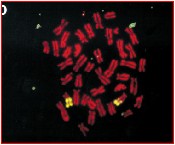
Triple stain with the class II a and b
and the class Ib (non-classical XNC
class I genes) on the B3B7 tumor cell line chromosomes.
From Courtet et al., (2001)
X laevis is the only species where aneuploid animal can be generated for studying the segregation of functions linked to a specific chromosome (Kobel et al., 1979). In situ hybridization techniques are now available both for chromosome (Courtet et al., 2001) and for whole-mount embryos (Pollet et al., 2003).